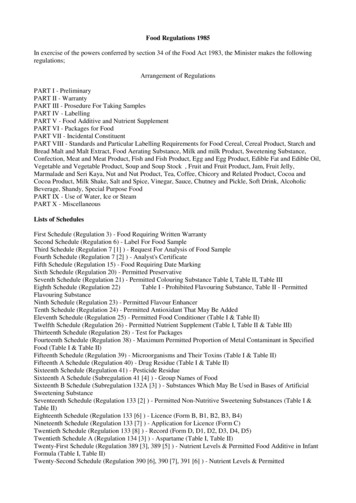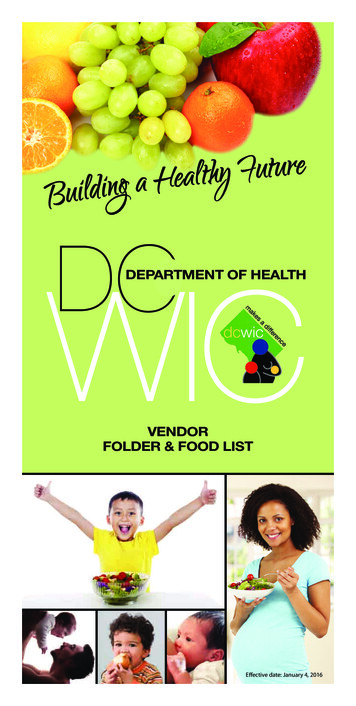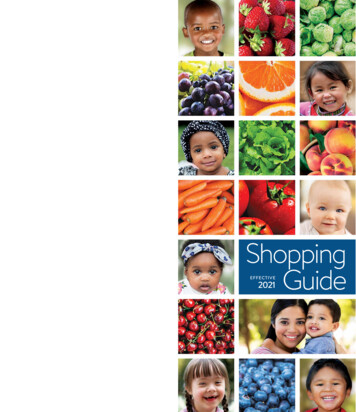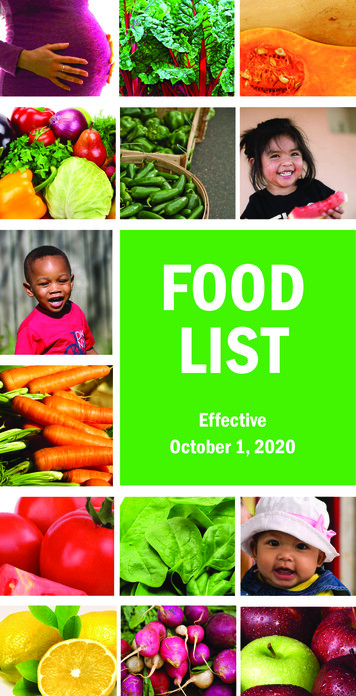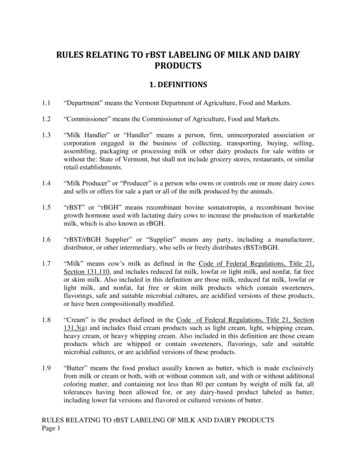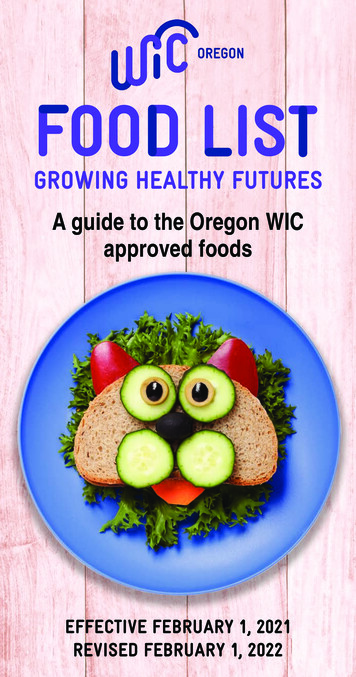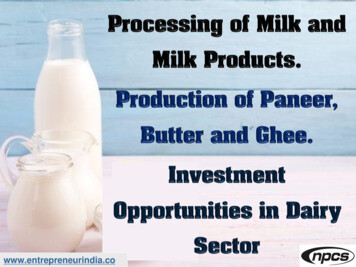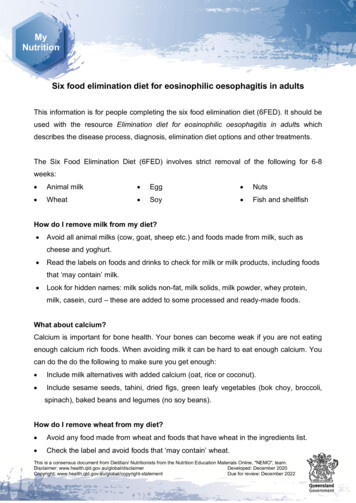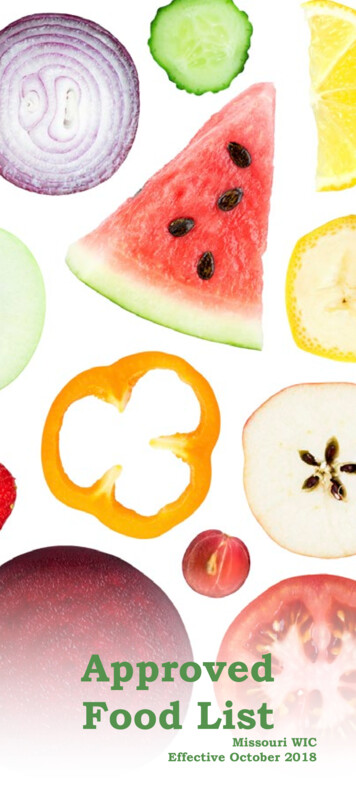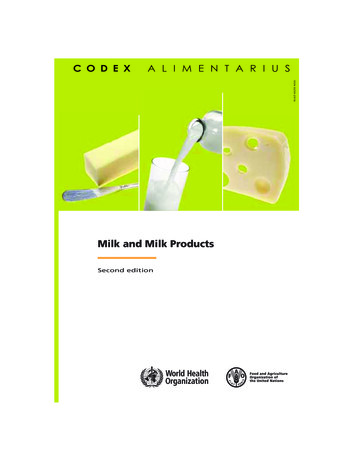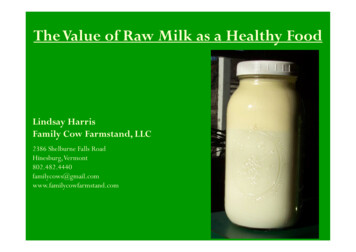
Transcription
The Value of Raw Milk as a Healthy FoodLindsay HarrisFamily Cow Farmstand, LLC2386 Shelburne Falls comwww.familycowfarmstand.com
Reasons People Buy our Milk Taste - creamy, but not heavy and has amazing flavor Health – use to treat cases of lactose intolerance, allergies, IBS, skinconditions, inflammation, depression, obesity and autism.(Recommended by health care professionals) Treat animals well –first hand view of clean, healthy, grass-fed cows Whole, real, unprocessed, grass-based food Trust – Have a connection with us and see our immaculate barn andsanitary conditions. Customers always comment on how nicely ourbarn smells. Support local – they like knowing their money is going directly to
Raw Milk has been a human staplefor 6,000 years! Raw milk has been long been a staple in many culturesacross the world. Evidence of early dairy farming in Northern Europe, India,Egypt, North Africa and elsewhere. Raw milk is mentioned more than 50 times in the bible. ‘Aland that floweth with milk and honey’ was the fertile and allproviding land of ancient Palestine.
What went wrong with raw milk? The industrial revolution spawned the first confinement farms “Swill dairies” associated with alcohol distilleries were diseasefilled, manure pits and very profitable! Milk watered down with contaminated water, sick dairyworkers and diseased cows spread illness Many people (especially babies) got sick or diedQuote from an observer of the day:“Confined to filthy, manure-filled pens, the unfortunate cows gave a pale,bluish milk so poor in quality, it couldn’t even be used for making butteror cheese.”.Schmid, Ron. The Untold Story of Milk. Winona Lake, Indiana: New Trends Publishing, 2003, p.232.
Raw Milk’s Regulatory CrossroadsPut cows back on the farm andgo back to making safe milk?orPasteurize swill milk so itwouldn’t kill people?
Widespread Pasteurization Kept low cost, low quality milk on the market Standardized Milk Ordinance Enacted in 1924, today this is called thePasteurized Milk Ordinance (PMO)This set of regulations, (now adopted by all states) has improved milk productionfrom the days of swill dairies, but it still allows large, crowded confinement dairy operations feeding of concentrates, industrial food wastes and GMO’s regular use of hormones co-mingled milk from many large farms and many thousands of cows allows milk from sick cows (acidosis, mastitis) to enter the food supply
Historic vs Modern Milk Risks Major communicable diseases associated with swill milk havelargely been eradicated from the US1(TB, Brucellosis and Typhoid) Scientific understanding and technological advances have mademilk (raw and pasteurized) a relatively safe food2,3,4 Testing, vaccinations, water chlorination, and pasteurization ofcontaminated milk have greatly increased milk safety
References for Previous Slide 1. Schmid, Ron. The Untold Story of Milk. Winona Lake, Indiana: New TrendsPublishing, 2003, p.232. 2. Elmoslemany, A.M. et. al. (2009) “Risk factors for bacteriological quality ofbulk tank milk in Prince Edward Island dairy herds. Part 1: Overall risk factors” J.Dairy Sci. 92:2634-2643 3. Millogo, V., et. al. (2010) “Raw milk hyginene at farms, processing units andlocal markets in Burkina Faso” Food Control. Doi:10.1016/j.foodcont.2009.12.029. 4. Centers for Disease Control. (2007). “FOIA 06-0819 Line list of foodborneillness reoported to CDC’s National Foodborne Outbreak Surveillance System from1973 to 2005” Available online at df (accessed April 27, 2010)
CDC’s Current Milk Safety Data FOIA request from FTCLDF outlines 33 years (1973-2005) of dataon raw and pasteurized milk outbreaks in the U.S.1 1,585 total illnesses attributed to raw milk(average of 48 illnesses per year in the US) 19,835 total illnesses attributed to pasteurized milk (average of 601illnesses per year in the US)“Raw milk’s contribution to the nation’s foodborne illness problem [is]miniscule.”-David Gumpert (journalist, author, in response toCDC’s Report on Raw Milk Outbreaks)1. Centers for Disease Control. (2007). “FOIA 06-0819 Line list of foodborne illness reoported to CDC’sNational Foodborne Outbreak Surveillance System from 1973 to 2005” Available online i.pdf (accessed April 27, 2010)
CDC Food Borne Illness Data CDC data show that 27,645 foodborne illnesses were reported in 20061 According to CDC statistics, 48 out of 27,645 total foodborne illnesses each yearin the US are attributed to raw milk 2 This means 0.17% of foodborne illnesses are caused by raw milk in the U.S. In 2006, the food commodities associated with the largest number of illnesses werepoultry (21%), leafy vegetables (17%) and fruits or nuts (16%).1. Medicine.net”Foodborne Illness Underreported” Online rticlekey 101137 (Accessed April 27, 2010)2. Centers for Disease Control. (2007). “FOIA 06-0819 Line list of foodborne illness reoported toCDC’s National Foodborne Outbreak Surveillance System from 1973 to 2005” Available online i.pdf (accessed April 27, 2010)
Raw Milk Consumption Rates 2002 CDC Survey of consumers in 9 states, estimates the percentage of raw milkdrinkers to be between 2.5% and 4%1 Extrapolating nationally, there are 7-12 million raw milk drinkers in the U.S.2 Largest retail raw milk farm is Organic Pastures Dairy in Fresno, Ca. which providesraw milk and raw milk products to 35,000 regular consumers2 Survey of Vermont dairy farmers estimates that over 175,000 gallons of raw milkwill be sold in Vermont in 2010.31. Centers for Disease Control and Prevention. Foodborne Diseases Active Surveillance Network (FoodNet): Population Survey Atlas ofExposures, 2002. Atlanta: Centers for Disease Control and Prevention, 2004, pp.204-205.2. Gumpert, David The Raw Milk Revolution. White River Junction, Vermont: Chelsea Green Publishing, 2009. pp243.3. Moyer, Brian (2010) “Unpasteurized (Raw) Milk Report” Submitted to Vermont House Agriculture Committee.
Risks Adjusted for Consumption of Milk (raw andpasteurized) Compared With Other FoodsCenter for Science in the Public InterestChart data provided byWeston A. Price Foundation. “Raw Milk PowerPoint--NOVEMBER 2009 Update” (2009).Available online at http://realmilk.com/ppt/index.html (Accessed April 27, 2010.)
Statistical Evidence that Raw Milk isNot More Dangerous than Other Foods In a 2003 USDA/FDA report: Compared to raw milk515 times more illnesses from Listeria due to deli meats29 times more illnesses from Listeria due to pasteurized milk1When adjusted for consumption rates, delimeats present a 10x greater risk oflisteriosis then raw milk.1.Interpretive Summary – Listeria Monocytogenes Risk Assessment,Center for Food Safety and Applied Nutrition, FDA,USDHHS, USDA, Sept. 2003, page 17Data provided by Weston A. Price Foundation. “Raw Milk PowerPoint--NOVEMBER 2009 Update” (2009).Available online at http://realmilk.com/ppt/index.html (Accessed April 27, 2010.)
You are ten times more likely toget listeriosis from your turkeysandwich then from drinking aglass of raw milk.
Two Raw Milks, All Raw Milk is NOTCreated Equally Scientific evidence shows that pasture based animal products are safer and ofsuperior nutritional quality than food from confinement systems. The following is a conclusion reached in Dr. Cathy Donnelly’s recent paperin the Journal of Dairy Science.“Our results indicated that most raw milk intended for small-scale artisancheesemaking in Vermont was of high microbiological quality with nodetectable target pathogens despite the repeat sampling of farms. Thissuggests that factors inherent to small herds and flock sizes, the lack ofextended milk holding, seasonal milking, and pasture-based feeding play arole in the overall quality of milk.”11. D’Amico, D.J., and C.W. Donnelly. 2010 Microbiological quality of raw milk used for small-scale artisan cheese production in Vermont: Effect of farmcharacteristics and practices. J. Dairy Sci. 93:134-147
This milk is produced specifically tobe consumed without pasteurization.
This milk is produced specifically tobe consumed after pasteurization.
I DO NOT recommendconsumption of this milk, rawor pasteurized!
Confinement Dairy Production 95% of US milk is from confinement operations Confinement animals are many times more likely to harbor humanpathogens1,2,3 Development of antibiotic resistant pathogens linked to subtherapeutic use of antibiotics in animals in confinement6 Udder infections, acidic rumens, lameness, high cull rates aremore prevalent then in pasture-based systems4,5 Quality of food produced from confined animals has been shownto have unhealthy proportions of Omega 3,6,9 ratios7
References from Previous Slide1. Russell, J. B., F. Diez-Gonzalez, and G. N. Jarvis. "Potential Effect of Cattle Diets on the Transmission ofPathogenic Escherichia Coli to Humans" Microbes Infect 2, no. 1 (2000): 45-53.2. Bailey, G. D., B. A. Vanselow, et al. (2003). "A study of the food borne pathogens: Campylobacter,Listeria and Yersinia, in faeces from slaughter-age cattle and sheep in Australia." Commun Dis Intell 27(2):249-57.3. "Influence of Diet on Total and Acid Resistant E. coli and Colonic pH." Tony Scott, Klopfenstein, T., etal." 2000 Nebraska Beef Report, pages 39-41.4. Bramley, E. et al. (2008) “The Definition of Acidosis in Dairy Herds Predominantly Fed on Pasture andConcentrates” j. Dairy Sci. 91:308-321.5. Goldberg, J. J., et al. (1991) “The Influence of Intensively Managed Rotational Grazing, TraditionalContinuous Grazing, and Confinement Housing on Bulk Tank Milk Quality and Udder Health” J. DairySci 75:96-104.6. Kennedy, Donald “Cows on Drugs” (April 17, 2010) New York Times. Available online edy.html. (Accessed April 27, 2010.)7. Couvreur, S., et al. “The Linear Relationship between the Proportion of Fresh Grass in the Cow Diet,Milk Fatty Acid Composition, and Butter Properties” J. Dairy Sci., 2006. 89:1956-1969.
PMO vs Vermont Raw Milk StandardsBacterial Limits Allowed by Lawcells per ml350000Grade A Raw MilkBound 00100000500000Grade A Raw MilkBound for Past. (ona single farm)Grade APasteurized Milk (in Vermont Certifiedthe store)Raw Milk
PMO vs Vermont Raw Milk StandardsColiform Limits Allowed by Law120*the PMO does not requiretesting of coliform levels inwholesale milk at the farmCells per ml1008060Grade A PasteuizedMilk in BulkTransport40200Grade A Pasteurized Vermont CertifiedMilk - in the storeRaw Milk
PMO vs Vermont Raw Milk StandardsSomatic Cell Count (Herd Average) Limits Required by Law800000700000Cells per ml600000500000400000300000Grade A Raw MilkBound forPasteuriztaion2000001000000Vermont CertifiedRaw Milk
The Health Enhancing Properties ofGrass-Fed Raw Milk Probiotics – maintains healthy gut flora which enhancesimmune function and reduces chronic inflammation Intact Enzymes – enables complete protein digestion andmineral absorption CLA’s– shown to decrease risk of chronic illness Healthy fats - Omega 3,6,9 in balance Full compliment of vitamins and minerals
Probiotics, Necessary for a FunctioningImmune SystemDr. Robert Luby, is a Colombia trained, 20 year practitioner of family medicine,with teaching appointments at UVM, the University of Massachusetts and TuftsUniversity medical schools. Dr. Luby recommends patients replace pasteurizedmilk with pasture-based raw milk as a first line therapy. He has had goodresults, especially in patients with asthma, seasonal allergies and eczema. Belowis a quote from him.“I challenge you to consider that there are 5 macronutrients rather than three; fat,protein, carbohydrates PLUS fiber and beneficial bacteria as well. Beneficialbacteria are the most important nutrient in milk and are destroyed duringpasteurization. We are the first society in history to not regularly consumelarge amounts of probiotic, beneficial bacteria laden foods. The results areshockingly increasing rates of chronic disease such as heart disease, diabetes andcancer.”
Allergies and Asthma European study involving 15,000 children shows a directlink to raw milk and decreased rates of allergies andasthma1 Ruled out other factors such as exposure to the farmenvironment Concludes that protective effect may be transferred tonon-farm populations through raw milk consumption1. Waser, M., et al. “Inverse Association of Farm Milk Consumption with Asthma and Allergy in Rural andSuburban Populations Across Europe.” Clinical and Experimental Allergy 37.5 (2007): 661-670.
Lactose Intolerance Caused by insufficient levels of the lactase enzymein the gut1 Raw milk contains bacteria which produces theenzyme lactase 2,3 Survey of lactose intolerant, raw milk drinkersfinds that 83% can digest raw milk with noproblem Very common reason consumers seek out rawmilk
References from Previous Slide 1. US FDA “Problems Digesting Dairy Products?” FDA ConsumerHealth Information Update series (2009). Available online atwww.fda.gov/consumer/updates/lactose032508.html. 2. Schmid, Ron. The Untold Story of Milk. Winona Lake, Indiana: NewTrends Publishing, 2003, p.232. 3. “What’s in Raw Milk” (2009). Available online at www.real-milkfacts.com/what is in raw milk.html. 4. Gumpert, David The Raw Milk Revolution. White River Junction,Vermont: Chelsea Green Publishing, 2009. pp243.
“Raw milk is good food. Raw milk is good medicine.Access to raw milk is access to health care.”-Dr. Robert LubyThank you!
Raw milk has been long been a staple in many cultures across the world. Evidence of early dairy farming in Northern Europe, India, Egypt, North Africa and elsewhere. Raw milk is mentioned more than 50 times in the bible. 'A land that floweth with milk and honey' was the fertile and all providing land of ancient Palestine.
